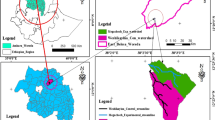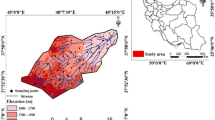Abstract
The tank systems spread across Karnataka in southern India serve as traditional but sustainable means of water harvesting and flood control measures and a source of protective irrigation. In recent decades, these are fast losing their storage capacity due to sedimentation. To derive appropriate plans for rate of desiltation and reclamation, ruling rate of sedimentation and life expectancy of these tanks need to be estimated. The present investigation aims at predicting sedimentation rate of 254 tanks spread over different agro-climatic zones of Karnataka to assess the influence of climatic conditions along with topography and soil conditions. The modified Morgan Finney, a lumped sediment yield model, was used which agreed well with the measured sediment yield through capacity-contour and sediment concentration methods. The sediment yield (0.7–1.1 kg m−2) rate does get influenced by climate, the slope and soil characteristics together and would help in evolving desiltation plans. The life expectancy of the sample tanks varied from 2.0 to 85.1 years.



Similar content being viewed by others
References
Govindasamy R, Balasubramanian R (1990) Tank irrigation in India-problems and prospects. Int J Water Resour Dev 6:211–217
Itakura J (1995) Water balance model for planning rehabilitation of irrigation tank cascade system in Sri Lanka. IIMI Working Paper No. 37, International Water Management Institute, Colombo, Sri Lanka. p 61
Jayatilaka CJ, Sakthivadivel R, Shinogi Y, Makin IW, Witharana P (2001) Predicting water availability in irrigation tank cascade systems: the cascade water balance model. Research report No 48. International Water Management Institute, Colombo, Sri Lanka. p 41
Karthikeyan KA, Murugappan S, Senthilkumar G (2003) Frequency analysis of rainfall: inter-comparison of plotting position formulae. In: Singh VP, Yadava PN (ed) Watershed hydrology. Proceedings of the international conference on water and environment (WE 2003) December 15–18, 2003, Allied Publishers, Bhopal, India, pp 448–458
Morgan RPC (2001) A simple approach to soil loss prediction: a revised Morgan–Morgan–Finney model. Catena 44:305–322
Ouyang D, Bartholic J, Selegean J (2005) Assessing sediment loading from agricultural croplands in the Great Lakes Basin. J Am Sci 1(2):14–21
Pathak P, Laryea KB, Sudi R (1989) A runoff model for small watersheds in the semi-arid tropics. Trans Am Soc Agric Eng 32:1619–1624
Sakthivadivel RS, Savadamuthu CR, Balakrishnan PK, Arputharaj C (2003) A pilot study of modernization of tank irrigation in Tamil Nadu. In: Proceedings of the international workshop on modernization of tank irrigation systems: problems and issue, Centre for Water Resources, Anna University, pp 1–16
Verstraeten G, Poesen J (2000) Estimating trap efficiency of small reservoirs and ponds: methods and implications for the assessment of sediment yield. Prog Phys Geogr 24:219–251
World Bank (2002) Project appraisal document for the Karnataka community-based tank management project. Report No 23555-IN, World Bank, Washington, DC, p 97
Acknowledgments
We wish to acknowledge the assistance rendered by field staff in different tank sites and laboratory technicians for sediment analysis. We would like to place on record that this work was part of the Karnataka Community Based Tank Management Project funded by World Bank through Jala Samvardhane Yojana Sangha, Govt. of Karnataka.
Author information
Authors and Affiliations
Corresponding author
Rights and permissions
About this article
Cite this article
Satishkumar, U., Dasog, G.S., Balakrishnan, P. et al. Assessment of Sedimentation Rate in Rain-Fed Irrigation Tank Systems Under Different Agro-Climatic Zones in Karnataka, India. Agric Res 6, 47–56 (2017). https://doi.org/10.1007/s40003-016-0237-3
Received:
Accepted:
Published:
Issue Date:
DOI: https://doi.org/10.1007/s40003-016-0237-3




